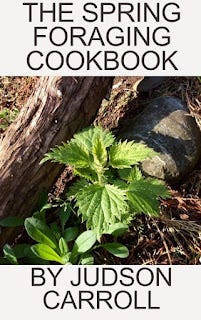The root of this plant tastes remarkably like cucumber and has a nice, crunchy texture. It is very good used fresh in a salad or pickled. Indian cucumber is abundant where I live, so I get to enjoy them. Remember, though, that with plants such as this, we kill the plant by taking the root. Irresponsible harvesting can really devastate the population of Indian Cucumber…. Take only what you need, when there is enough growing so that the plants will not be wiped out. Remember, critters like these roots too, so don’t assume that just because you leave a few plants the stand will not be wiped out. I grow a few in my yard to be assured of having plenty of seeds for the next season – it is an attractive plant in my flower and wild herb beds.
Cold soup for a hot day
This is really just a variation on a traditional French cucumber soup recipe, using Indian Cucumber. But, I like it better because the Indian Cucumber has more crunch. I usually combine Indian Cucumber with garden cucumber and borage flowers (borage flowers also taste like cucumber).
Ingredients:
About 1 pound of Indian Cucumber roots, peeled and washed or a mix of Indian Cucumber with garden cucumbers, peeled and seeded.
1 cup plain yogurt
1 cup whole milk
About ½ cup each of borage flowers and fresh mint leaves
The juice of one lemon
Salt and pepper to taste.
Optional cooked crawfish tails, poached shrimp, lean fish, oysters, scallops, crab, etc.
Or, also optional, some fresh berries or other fruit
Basically, all you have to do is chop your veggies finely and salt to pull out some water and soften them a bit. Mix with the milk and yogurt. Add borage flowers, mint, lemon and pepper. Chill and serve with either poached seafood or fruit. If I use seafood, I also include chives or chopped green onions. I don’t think that is very traditional, but it works for my taste. If you use fruit, you could add a little honey or some jam. Either way, it is a very cooling dish for a hot day and very good with a glass of wine.
Speaking of wine, this combination of Wild Cucumber, garden cucumber and borage can be used in many ways. Flavoring wine or gin with cucumber and borage is very traditional. And, of course, tzatziki sauce is a combination of cucumber, plain yogurt and dill. If you want something hot and spicier for a cool day, look for cucumber curry recipes and use the same substitutions.
This article is an excerpt from
PS. New today in my Woodcraft shop:
Toasted Holly Cooking Spoon
https://judsoncarrollwoodcraft.substack.com/p/toasted-holly-cooking-spoon
Read about my other new books:
Herbal Medicine for Preppers, Homesteaders and Permaculture People: https://southernappalachianherbs.blogspot.com/2021/10/herbal-medicine-for-preppers.html
Available on Amazon: www.amazon.com/dp/B09HMWXL25
Medicinal Ferns and Fern Allies, an Herbalist's Guide https://southernappalachianherbs.blogspot.com/2022/11/medicinal-ferns-and-fern-allies.html
Available for purchase on Amazon: https://www.amazon.com/dp/B0BMSZSJPS
A Daily Catholic Devotional Reflections on the Daily Mass readings July-December, 2025
https://southernappalachianherbs.blogspot.com/2023/12/a-daily-catholic-devotional-reflections.html
Medicinal Weeds and Grasses of the American Southeast, an Herbalist's Guide
https://southernappalachianherbs.blogspot.com/2023/05/medicinal-weeds-and-grasses-of-american.html
Available in paperback on Amazon:
https://www.amazon.com/dp/B0C47LHTTH
and
Confirmation, an Autobiography of Faith
https://southernappalachianherbs.blogspot.com/2023/05/confirmation-autobiography-of-faith.html
Available in paperback on Amazon:
https://www.amazon.com/dp/B0C47Q1JNK
and
Medicinal Shrubs and Woody Vines of The American Southeast An Herbalist's Guide
Read about Medicinal Shrubs and Woody Vines of The American Southeast An Herbalist's Guide: https://southernappalachianherbs.blogspot.com/2022/06/medicinal-shrubs-and-woody-vines-of.html
Available for purchase on Amazon: https://www.amazon.com/dp/B0B2T4Y5L6: by Judson Carroll
Visit my Substack and sign up for my free newsletter:
Read about my new other books:
Medicinal Ferns and Fern Allies, an Herbalist's Guide https://southernappalachianherbs.blogspot.com/2022/11/medicinal-ferns-and-fern-allies.html
Available for purchase on Amazon: https://www.amazon.com/dp/B0BMSZSJPS
The Omnivore’s Guide to Home Cooking for Preppers, Homesteaders, Permaculture People and Everyone Else: https://southernappalachianherbs.blogspot.com/2022/10/the-omnivores-guide-to-home-cooking-for.html
Available for purchase on Amazon: https://www.amazon.com/dp/B0BGKX37Q2
Medicinal Shrubs and Woody Vines of The American Southeast an Herbalist's Guide
https://southernappalachianherbs.blogspot.com/2022/06/medicinal-shrubs-and-woody-vines-of.html
Available for purchase on Amazon https://www.amazon.com/dp/B0B2T4Y5L6
and
Growing Your Survival Herb Garden for Preppers, Homesteaders and Everyone Else
https://southernappalachianherbs.blogspot.com/2022/04/growing-your-survival-herb-garden-for.html
https://www.amazon.com/dp/B09X4LYV9R
The Encyclopedia of Medicinal Bitter Herbs: https://southernappalachianherbs.blogspot.com/2022/03/the-encyclopedia-of-bitter-medicina.html
Available for purchase on Amazon: https://www.amazon.com/dp/B0B5MYJ35R
and
Christian Medicine, History and Practice: https://southernappalachianherbs.blogspot.com/2022/01/christian-herbal-medicine-history-and.html
Available for purchase on Amazon: www.amazon.com/dp/B09P7RNCTB
Podcast: https://www.spreaker.com/show/southern-appalachian-herbs
Blog:
https://southernappalachianherbs.blogspot.com/
Free Video Lessons: Herbal Medicine 101 - YouTube
Disclaimer
The information on this site is not intended to diagnose or treat any disease or condition. Nothing on this site has been evaluated or approved by the FDA. I am not a doctor. The US government does not recognize the practice of herbal medicine and their is no governing body regulating herbalists. Therefore, I'm just a guy who studies herbs. I am not offering any advice. I won't even claim that anything I write is accurate or true! I can tell you what herbs have "traditionally been used for." I can tell you my own experience and if I believe an herb helped me. I cannot, nor would I tell you to do the same. If you use any herb I, or anyone else, mentions you are treating yourself. You take full responsibility for your health. Humans are individuals and no two are identical. What works for me may not work for you. You may have an allergy, sensitivity or underlying condition that no one else shares and you don't even know about. Be careful with your health. By continuing to read my blog you agree to be responsible for yourself, do your own research, make your own choices and not to blame me for anything, ever.






